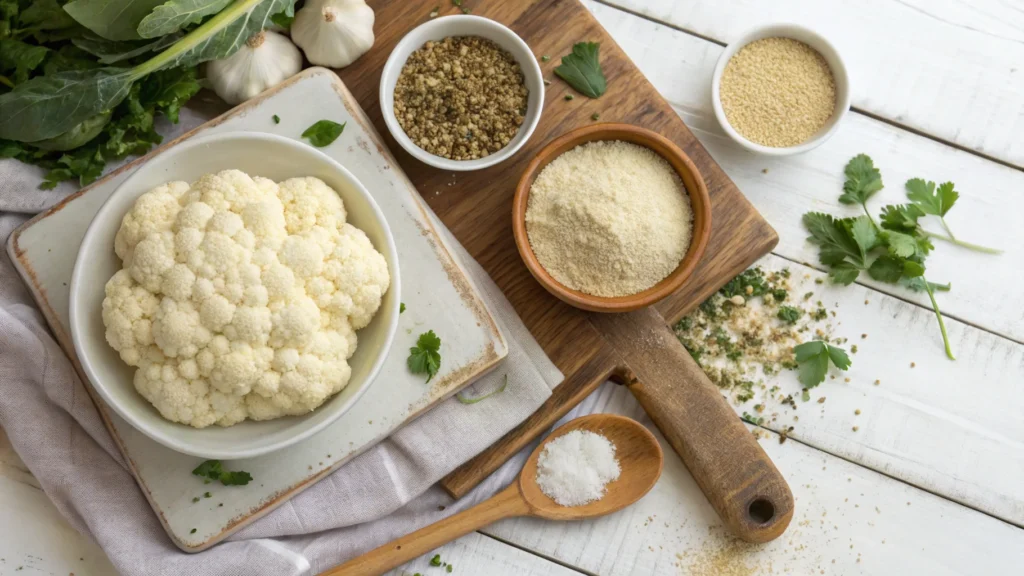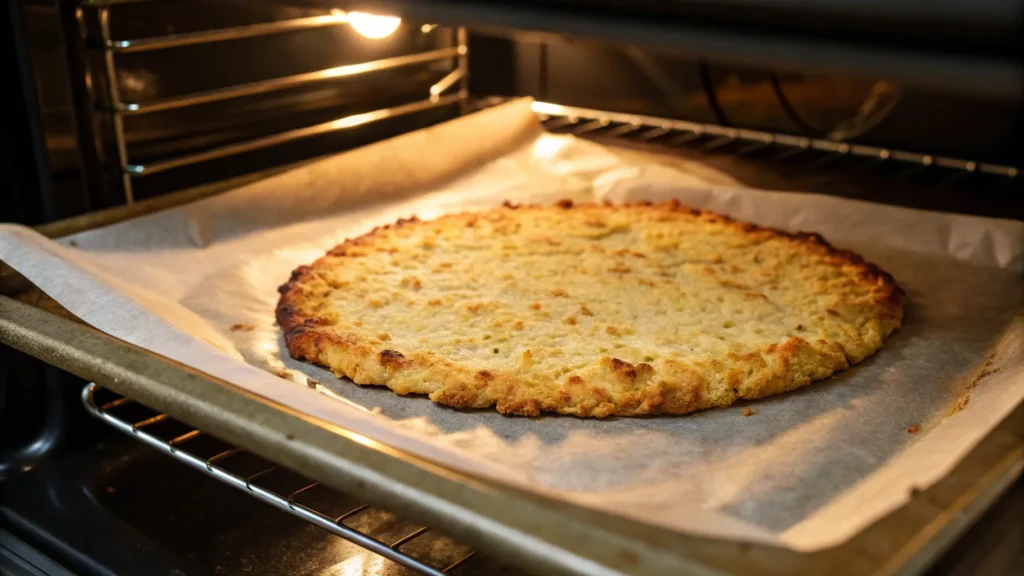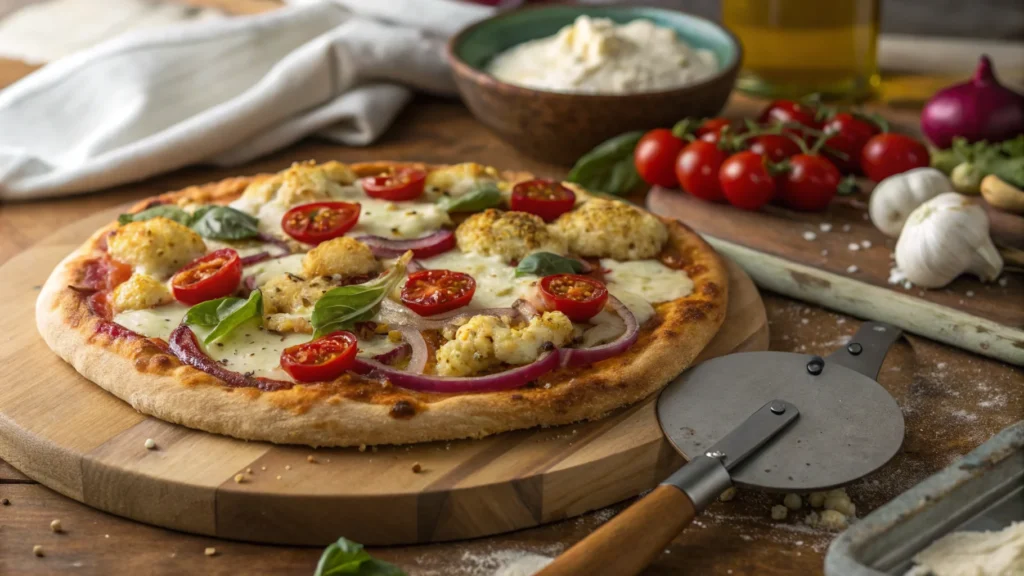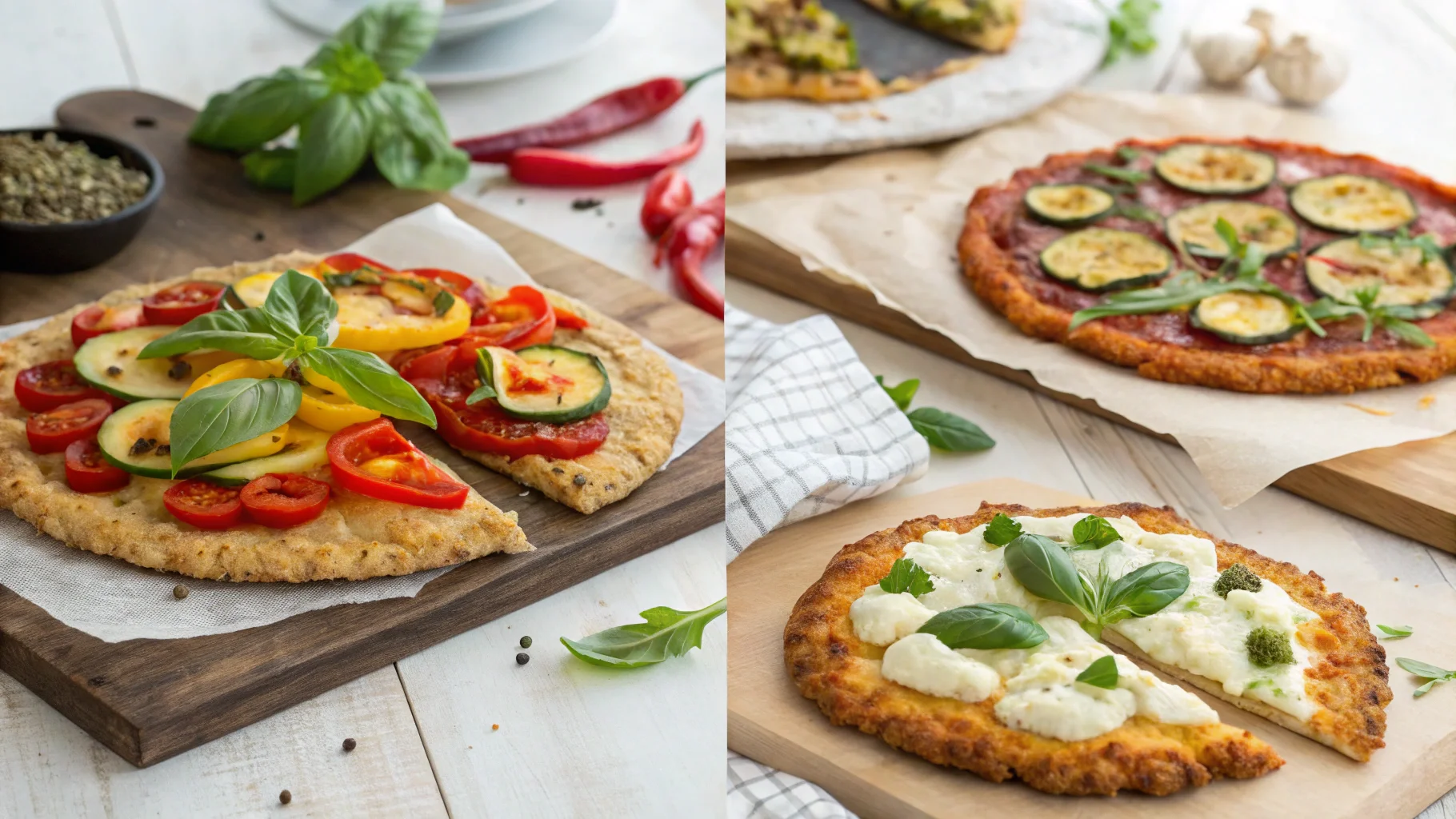If you love pizza but want a healthy, gluten-free, and plant-based alternative, you’re in the right place! A vegan cauliflower pizza crust is a fantastic way to enjoy your favorite comfort food without guilt. It’s packed with nutrients, low in carbs, and easy to customize with your favorite flavors and toppings.
In this guide, we’ll explore seven mouthwatering vegan cauliflower pizza crust recipes that are crispy, delicious, and 100% plant-based. We’ll also break down the best ingredients, common mistakes to avoid, and top storage tips. Whether you’re new to cauliflower crust or looking for a foolproof way to perfect it, this article has you covered!
Let’s get started with why you should switch to a vegan cauliflower pizza crust and the incredible benefits it offers.
Table of contents
- Why Choose a Vegan Cauliflower Pizza Crust?
- Essential Ingredients for a Perfect Vegan Cauliflower Pizza Crust
- 7 Vegan Cauliflower Pizza Crust Recipes
- Common Mistakes & Troubleshooting Cauliflower Pizza Crust
- Best Vegan Toppings for Cauliflower Pizza
- How to Store and Reheat Vegan Cauliflower Pizza Crust
- FAQs – Answering Popular Questions
- Final Thoughts – Why You Should Try Vegan Cauliflower Pizza Crust Today
Why Choose a Vegan Cauliflower Pizza Crust?
With the rise of plant-based eating, more people are looking for healthier pizza crust alternatives. A vegan cauliflower pizza crust isn’t just trendy—it’s a game-changer for anyone who wants a nutritious, gluten-free, and low-carb option. But why should you make the switch? Let’s break it down.
The Benefits of Cauliflower Crust
Cauliflower is a superfood that’s loaded with vitamins and fiber. Here’s why it makes an excellent pizza crust:
– Low in carbs – Traditional pizza crusts are high in refined carbs, while cauliflower keeps it light.
– Rich in nutrients – Packed with vitamin C, K, and antioxidants, cauliflower supports overall health.
– Naturally gluten-free – A great option for those with gluten sensitivities or celiac disease.
– Low in calories – Enjoy your pizza without worrying about extra calories!
By choosing a vegan cauliflower pizza crust, you get all these benefits while still indulging in your favorite dish.
Why Go Vegan? Health & Ethical Considerations
Going vegan isn’t just about avoiding animal products—it’s about embracing a healthier and more sustainable lifestyle. Many traditional pizza crust recipes contain eggs or cheese, but a vegan cauliflower pizza crust is completely dairy-free and egg-free.
Here’s why making a plant-based choice is a great idea:
– Better digestion – Vegan foods are easier on the stomach and gut.
– Lower cholesterol – No dairy means less saturated fat, which helps heart health.
– Cruelty-free – Supporting a diet free from animal exploitation.
Gluten-Free, Low-Carb, and Keto-Friendly Options
Another big perk of cauliflower pizza crust is its versatility. Whether you’re following a gluten-free, low-carb, or keto diet, this crust fits perfectly.
– Gluten-Free: Since cauliflower is naturally gluten-free, it’s a safe alternative for people with celiac disease.
– Low-Carb: With minimal carbs compared to wheat-based crusts, cauliflower is a great choice for those watching their carb intake.
– Keto-Friendly: By swapping out traditional flour for cauliflower and almond flour, you can create a keto-approved crust with healthy fats and fiber.
Essential Ingredients for a Perfect Vegan Cauliflower Pizza Crust
Crafting the perfect vegan cauliflower pizza crust requires the right mix of ingredients. While cauliflower is the base, the secret to a crispy, flavorful, and sturdy crust lies in the supporting elements. Whether you’re making a low-carb, gluten-free, or keto-friendly crust, these ingredients will help you achieve the best results.
The Base: Cauliflower Preparation Methods
Before anything else, you need to prepare the cauliflower properly. This step makes a huge difference in texture. Here are two common ways to do it:
- Fresh Cauliflower Rice – Chop a head of cauliflower into florets and pulse it in a food processor until it resembles rice.
- Frozen Cauliflower Rice – A convenient option! Just thaw it completely and squeeze out excess moisture before using.
Pro Tip: Always drain out as much water as possible! Excess moisture can make your crust soggy instead of crispy. Use a cheesecloth or kitchen towel to squeeze it dry.
Best Vegan Binders: Flaxseeds, Chia Seeds, and More
Traditional pizza crusts use eggs and cheese for binding, but in a vegan cauliflower pizza crust, you need plant-based alternatives to hold everything together.
🌱 Flaxseed or Chia Egg – Mix 1 tablespoon of flax or chia seeds with 3 tablespoons of water. Let it sit for 5 minutes until it forms a gel-like consistency.
🌱 Tapioca or Arrowroot Flour – These starches add elasticity, making the crust less crumbly.
🌱 Nutritional Yeast – Adds a cheesy, umami flavor while improving texture.
How to Achieve a Crispy and Firm Crust Without Dairy & Eggs
Getting the right crispiness in a vegan cauliflower pizza crust can be tricky, but these tips will help:
🔥 Pre-bake the crust – Always bake it before adding toppings! This prevents sogginess.
🔥 Use parchment paper – It stops sticking and ensures even cooking.
🔥 Don’t overload with toppings – Too much sauce or wet ingredients can make the crust soft.
Now that we’ve covered the must-have ingredients, let’s move on to the exciting part—the 7 best vegan cauliflower pizza crust recipes!

7 Vegan Cauliflower Pizza Crust Recipes
Ready to try some delicious and healthy pizza crusts? Below are seven unique vegan cauliflower pizza crust recipes, each with its own twist. Whether you like it classic, spicy, or protein-packed, there’s a recipe here for you!
1. Classic Vegan Cauliflower Pizza Crust
✔️ Simple, crispy, and perfect for any toppings!
Ingredients:
- 1 medium cauliflower head (riced and squeezed dry)
- 1 flaxseed egg (1 tbsp flaxseed + 3 tbsp water)
- ¼ cup almond flour
- 2 tbsp nutritional yeast
- ½ tsp garlic powder
- ½ tsp oregano
- ¼ tsp sea salt
Instructions:
- Preheat the oven to 400°F (200°C).
- Mix all ingredients in a bowl until well combined.
- Spread the mixture onto a baking sheet lined with parchment paper.
- Bake for 25 minutes or until golden brown.
- Add toppings and bake for another 10 minutes.
2. Oil-Free Vegan Cauliflower Pizza Crust
✔️ For those who prefer a completely oil-free and whole-food recipe.
Key Differences:
- Uses mashed sweet potato for extra binding and moisture.
- Completely free from oils or processed ingredients.
3. Gluten-Free Vegan Cauliflower Crust
✔️ A sturdy crust with zero gluten, but full of flavor!
Key Differences:
- Uses chickpea flour for extra protein and stability.
- Ideal for those with gluten sensitivities.
4. Almond Flour Vegan Cauliflower Crust
✔️ A nutty, slightly crispy alternative to traditional crusts.
Key Differences:
- Uses almond flour instead of wheat or starch-based binders.
- Provides healthy fats and a subtle, rich flavor.
5. Spicy Vegan Cauliflower Pizza Crust
✔️ For those who love a little heat in every bite!
Key Differences:
- Includes chili flakes and smoked paprika for spice.
- Pairs well with roasted veggies and dairy-free cheese.
6. Herb-Infused Vegan Cauliflower Crust
✔️ Packed with fresh herbs like basil, rosemary, and oregano.
Key Differences:
- Fresh herbs enhance aroma and taste.
- Best for Mediterranean-style pizzas.
7. High-Protein Vegan Cauliflower Crust
✔️ A great option for those who want more protein in their meals!
Key Differences:
- Uses chickpea flour and hemp seeds for protein boost.
- A hearty, filling crust with extra nutrition.
Common Mistakes & Troubleshooting Cauliflower Pizza Crust
Even the best home cooks make mistakes when preparing a vegan cauliflower pizza crust. If your crust turns out soggy, crumbly, or flavorless, don’t worry—we’ve got solutions to the most common issues so you can get it right every time!
Why Is My Crust Soggy? How to Fix It
A soggy crust is the number one complaint when making a vegan cauliflower pizza crust. Here’s what might be going wrong and how to fix it:
– Too much moisture in the cauliflower – Always squeeze out as much liquid as possible using a cheesecloth or kitchen towel.
– Skipping pre-baking – Bake the crust before adding toppings to ensure it firms up.
– Too many wet toppings – Avoid watery vegetables like tomatoes or zucchini unless you roast them first.
Fix It: Make sure the crust is golden brown and firm before adding sauce and toppings. If needed, bake for an extra 5 minutes!
Getting the Right Texture Without Cheese or Eggs
Traditional pizza crusts rely on cheese and eggs for structure, but a vegan cauliflower pizza crust needs alternative binders.
💡 Solution: Use a mix of flax eggs, chickpea flour, and almond flour to keep the crust firm. Also, don’t forget to let the crust cool for a few minutes before slicing—it helps hold everything together!
Preventing the Crust from Falling Apart
If your crust keeps breaking apart, it’s likely due to a lack of binders or incorrect baking temperature.
– Use enough flax or chia egg – This helps create a solid dough.
– Press the dough firmly onto the baking sheet – A thin, even layer prevents cracking.
– Bake at the right temperature – Too low, and the crust stays soft; too high, and it burns before setting.
By following these troubleshooting tips, your vegan cauliflower pizza crust will turn out crispy, firm, and absolutely delicious!
Best Vegan Toppings for Cauliflower Pizza
Once your vegan cauliflower pizza crust is baked to perfection, it’s time for the fun part—choosing the best plant-based toppings!
Dairy-Free Cheese Alternatives That Melt Well
Traditional cheese is off the table, but don’t worry! There are amazing vegan cheese options that melt beautifully.
– Cashew Cheese – Creamy, rich, and easy to make at home.
– Nutritional Yeast & Tahini Mix – A budget-friendly option that adds a cheesy flavor.
– Vegan Mozzarella – Brands like Violife and Daiya melt well on pizza.
Best Plant-Based Protein Toppings
Want to add some extra protein to your pizza? Here are some top choices:
– Marinated tofu – Cubed and lightly baked for extra texture.
– Chickpeas – Roasted chickpeas add crunch and protein.
– Vegan sausage – A great option for a hearty, protein-packed pizza.
Creative Sauce Ideas Beyond Traditional Tomato
While classic tomato sauce is always a winner, there are other sauces that take your cauliflower pizza to the next level!
🍃 Pesto Sauce – A blend of basil, garlic, and nuts for a fresh, herby flavor.
🌶 Spicy Sauce – Perfect for a spicy cauliflower pizza.
🧄 Garlic Cashew Cream – A creamy, dairy-free alternative that pairs well with roasted veggies.

How to Store and Reheat Vegan Cauliflower Pizza Crust
Once you’ve made the perfect vegan cauliflower pizza crust, you might be wondering how to store leftovers or prep ahead for easy meals. The good news? This crust keeps well and reheats beautifully when stored correctly!
Keeping the Crust Fresh: Fridge & Freezer Tips
If you plan to eat your pizza within a couple of days, storing it in the fridge is the way to go. For longer storage, freezing works best.
📌 Fridge Storage:
- Let the crust cool completely before storing it.
- Wrap it tightly in plastic wrap or place it in an airtight container.
- It stays fresh for 3-4 days.
📌 Freezer Storage:
- Pre-bake the crust and let it cool.
- Wrap it in parchment paper, then place it in a freezer-safe bag.
- Store for up to 3 months.
🌟 Pro Tip: If you’re making multiple crusts, separate them with parchment paper before freezing. This makes it easy to grab one at a time!
Reheating Without Losing Crispiness
Want to enjoy your 7 vegan cauliflower pizza crust recipe without it turning soggy? Follow these reheating tips!
Oven Method (Best Option!):
- Preheat the oven to 375°F (190°C).
- Place the crust directly on the rack for extra crispiness.
- Heat for 8-10 minutes or until warm and firm.
Stovetop Method:
- Heat a skillet over medium heat.
- Place the crust in the pan and cover it.
- Cook for 5-7 minutes, checking for crispiness.
Air Fryer Method (Quick & Crispy!):
- Set the air fryer to 350°F (175°C).
- Heat for 5 minutes, checking halfway through.
🚫 Avoid the microwave! It makes the crust soggy instead of crispy. If you must use it, keep the power low and reheat in short bursts.
FAQs – Answering Popular Questions
Still have questions about making the perfect vegan cauliflower pizza crust? Here are some common questions and expert answers to help!
Can I Make Vegan Cauliflower Pizza Crust Without a Food Processor?
Absolutely! If you don’t have a food processor, try these alternatives:
🔪 Knife & Grater Method – Finely chop cauliflower with a knife, then grate it for a rice-like texture.
🥄 Pre-Riced Cauliflower – Many grocery stores sell frozen or fresh cauliflower rice. Just thaw and squeeze out moisture!
How Do I Make My Crust Less Dry?
If your crust is too dry or crumbly, try these quick fixes:
💧 Add moisture – A little olive oil or an extra flax egg can help.
🌾 Use almond or chickpea flour – These flours help balance moisture while keeping it gluten-free.
🔥 Don’t overbake – Take it out once it’s golden brown!
What’s the Best Way to Keep It from Sticking?
A stuck crust is frustrating, but here’s how to avoid it:
– Always use parchment paper – It prevents sticking and helps with easy removal.
– Grease the pan lightly – A little oil can make a big difference.
– Use a non-stick baking mat – This works just like parchment paper and is reusable!
Can I Use Frozen Cauliflower Instead of Fresh?
Yes! Frozen cauliflower works just as well as fresh, but you must squeeze out excess moisture before using it. Otherwise, the crust will turn soggy.
🌟 Pro Tip: Thaw the frozen cauliflower completely, then press out the liquid using a kitchen towel or cheesecloth.
Is Cauliflower Crust Healthier Than Regular Dough?
Definitely! A vegan cauliflower pizza crust is naturally low-carb, gluten-free, and packed with fiber. Compared to traditional pizza dough, it has:
– Fewer calories – Perfect for a lighter meal.
-️ More vitamins – Cauliflower is rich in vitamin C, K, and antioxidants.
-️ Less processed ingredients – No refined flours or artificial additives!

For another delicious cauliflower-based recipe, check out the Best Cauliflower Wings Recipe on RecipesOlly. These crispy, flavorful wings are a fantastic plant-based alternative to traditional chicken wings—perfect for pairing with your vegan pizza!
Final Thoughts – Why You Should Try Vegan Cauliflower Pizza Crust Today
After exploring the 7 vegan cauliflower pizza crust recipe, it’s clear that this healthy, delicious, and plant-based alternative is worth trying! Whether you’re looking for a low-carb, gluten-free, or dairy-free option, cauliflower crust is a versatile and nutritious choice.
A Delicious & Healthy Alternative to Traditional Pizza
Switching to a vegan cauliflower pizza crust doesn’t mean sacrificing flavor. In fact, with the right seasonings and toppings, it can be even more flavorful than traditional dough! Plus, it’s:
– Packed with nutrients – Loaded with fiber, vitamins, and antioxidants.
– Light and low in carbs – A great option for those watching their intake.
– Completely plant-based – Perfect for vegans and those with dietary restrictions.
Experimenting with Flavors & Customization
One of the best things about cauliflower pizza crust is how easy it is to customize. You can:
🔥 Make it spicy by adding chili flakes or jalapeños.
🌿 Infuse it with herbs like basil, oregano, or rosemary.
🥑 Go high-protein with chickpea flour and plant-based toppings.
Encouraging More People to Try Plant-Based Eating
By making simple swaps like a vegan cauliflower pizza crust, you’re embracing a healthier, more sustainable lifestyle. You don’t have to be fully vegan to enjoy plant-based meals—every small change counts!

